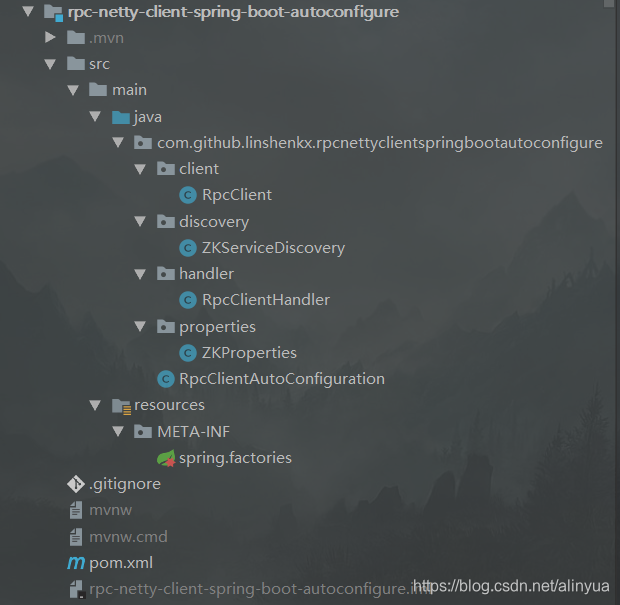RPC-Client模块负责创建 动态代理对象 供 服务消费者 使用,而动态代理对象的方法执行则是通过RPC调用RPC-Server的服务实现。即RPC-Client屏蔽了底层的通信过程,使得服务消费者可以基于接口透明使用服务提供者的服务。
系列文章:
从零写分布式RPC框架 系列 1.0 (1)架构设计
从零写分布式RPC框架 系列 1.0 (2)RPC-Common模块设计实现
从零写分布式RPC框架 系列 1.0 (3)RPC-Server模块设计实现
从零写分布式RPC框架 系列 1.0 (4)RPC-Client模块设计实现
从零写分布式RPC框架 系列 1.0 (5)整合测试
使用gpg插件发布jar包到Maven中央仓库 完整实践
文章目录
一 介绍
1 整体结构

2 模块介绍
整体结构如下:
- RpcClient
RPC-Client模块核心类,也是服务消费者会直接使用到的类。该类负责根据传入的接口类,生成一个可以执行远程方法的动态代理对象。 - ZKServiceDiscovery
主要负责 服务发现 ,根据服务名从ZK集群中获取相应RPC-Client地址信息 - RpcClientHandler
Rpc客户端处理器,将RPC-Server返回的RpcResponse对象存入管理。 - ZKProperties
属性注入类。 - RpcClientAutoConfiguration 和 spring.factories
封装成spring-boot-starter所需配置,开启自动装配。
3 工作流程
二 pom文件
<?xml version="1.0" encoding="UTF-8"?>
<project xmlns="http://maven.apache.org/POM/4.0.0" xmlns:xsi="http://www.w3.org/2001/XMLSchema-instance"
xsi:schemaLocation="http://maven.apache.org/POM/4.0.0 http://maven.apache.org/xsd/maven-4.0.0.xsd">
<modelVersion>4.0.0</modelVersion>
<artifactId>rpc-netty-client-spring-boot-autoconfigure</artifactId>
<parent>
<groupId>com.github.linshenkx</groupId>
<artifactId>rpc-netty-spring-boot-starter</artifactId>
<version>1.0.5.RELEASE</version>
<relativePath>../</relativePath>
</parent>
<dependencies>
<dependency>
<groupId>org.springframework.boot</groupId>
<artifactId>spring-boot-starter</artifactId>
</dependency>
<dependency>
<groupId>org.springframework.boot</groupId>
<artifactId>spring-boot-configuration-processor</artifactId>
</dependency>
<dependency>
<groupId>com.github.linshenkx</groupId>
<artifactId>rpc-netty-common</artifactId>
</dependency>
<dependency>
<groupId>org.projectlombok</groupId>
<artifactId>lombok</artifactId>
<optional>true</optional>
</dependency>
<dependency>
<groupId>io.netty</groupId>
<artifactId>netty-all</artifactId>
</dependency>
<dependency>
<groupId>com.101tec</groupId>
<artifactId>zkclient</artifactId>
</dependency>
</dependencies>
</project>
三 简单组件:属性注入类和自动装配类
属性装配类ZKProperties和RPC-Server的基本一致,自动装配类也是,原理相通。RpcClientAutoConfiguration源码如下
可以看到整个过程要管理的类其实比RPC-Server的要少很多。
/**
* @version V1.0
* @author: lin_shen
* @date: 2018/11/2
* @Description: TODO
*/
@Configuration
@EnableConfigurationProperties
@ConditionalOnClass(RpcClient.class)
public class RpcClientAutoConfiguration {
@ConditionalOnMissingBean
@Bean
public ZKProperties defaultZKProperties(){
return new ZKProperties();
}
@ConditionalOnMissingBean
@Bean
public ZKServiceDiscovery zkServiceDiscovery(){
return new ZKServiceDiscovery();
}
@Bean
public RpcClient rpcClient(){
return new RpcClient();
}
}
四 ZKServiceDiscovery
如下,核心方法为 discover,用于根据服务名从ZK集群获取到提供该服务的RPC-Server信息。
/**
* @version V1.0
* @author: lin_shen
* @date: 2018/10/31
* @Description: zookeeper服务注册中心
*/
@Component
@Log4j2
@EnableConfigurationProperties(ZKProperties.class)
public class ZKServiceDiscovery {
@Autowired
private ZKProperties zkProperties;
/**
* 为客户端提供地址
* 根据服务名获取服务地址
* @param serviceName
* @return
*/
public String discover(String serviceName){
ZkClient zkClient = new ZkClient(getAddress(zkProperties.getAddressList()), zkProperties.getSessionTimeOut(), zkProperties.getConnectTimeOut());
try {
String servicePath=zkProperties.getRegistryPath()+"/"+serviceName;
//找不到对应服务
if(!zkClient.exists(servicePath)){
throw new RuntimeException("can not find any service node on path: "+servicePath);
}
//该服务下无节点可用
List<String> addressList=zkClient.getChildren(servicePath);
if(CollectionUtils.isEmpty(addressList)){
throw new RuntimeException("can not find any address node on path: "+servicePath);
}
//获取address节点地址
String address=getRandomAddress(addressList);
//获取address节点的值
return zkClient.readData(servicePath+"/"+address);
}finally {
zkClient.close();
}
}
public String getAddress(List<String> addressList){
if(CollectionUtils.isEmpty(addressList)){
String defaultAddress="localhost:2181";
log.error("addressList is empty,using defaultAddress:"+defaultAddress);
return defaultAddress;
}
//待改进策略
String address= getRandomAddress(addressList);
log.info("using address:"+address);
return address;
}
private String getRandomAddress(List<String> addressList){
return addressList.get(ThreadLocalRandom.current().nextInt(addressList.size()));
}
}
五 RpcClient
整个模块的核心类,用于生成服务的动态代理类并实现远程方法调用。
create 方法
根据传入接口类返回动态代理类
主要使用了JDK的Proxy.newProxyInstance方法,其最关键的步骤就是实现InvocationHandler的invoke方法,这个时候便可以根据传入数据,构造封装成RpcRequest对象,然后利用 ZKServiceDiscovery 获取对于RPC-Server的地址信息。再调用send方法将RpcRequest发送到对应地址,并获取RpcResponse,再对RpcResult处理(如区分是否有异常等),返回最终的处理结果。完成invoke方法的实现。
send方法
根据RpcRequest对象和Rpc-Server地址信息,创建Netty连接,将RpcRequest发送到Rpc-Server并获取RpcResponse。
responseMap成员
responseMap的作用是作为一个中介暂存RpcResponse,因为Netty的RpcClientHandler在获取到RpcResponse对象还无法直接返回给send方法,所以就将其放入responseMap中,再由send方法根据RpcResponse对应的RequestId去获取。
需要注意,responseMap是 ConcurrentHashMap 类型的。因为目前的流程是每执行一次Rpc方法即执行一次Rpc调用都需要建立、断开netty连接,并且在这个过程需要根据requestId存放RpcResponse再将其移除。需要保证responseMap的线程安全。
/**
* @version V1.0
* @author: lin_shen
* @date: 2018/11/1
* @Description: TODO
*/
@Log4j2
@Component
@AutoConfigureAfter(ZKServiceDiscovery.class)
public class RpcClient {
@Autowired
private ZKServiceDiscovery zkServiceDiscovery;
/**
* 存放请求编号与响应对象的映射关系
*/
private ConcurrentMap<String, RpcResponse> responseMap=new ConcurrentHashMap<>();
@SuppressWarnings("unchecked")
public <T> T create(final Class<?> interfaceClass){
//创建动态代理对象
return (T) Proxy.newProxyInstance(interfaceClass.getClassLoader(),
new Class<?>[]{interfaceClass},
new InvocationHandler() {
@Override
public Object invoke(Object proxy, Method method, Object[] args) throws Throwable {
//创建RPC请求对象
RpcRequest rpcRequest=new RpcRequest();
rpcRequest.setRequestId(UUID.randomUUID().toString());
rpcRequest.setInterfaceName(method.getDeclaringClass().getName());
rpcRequest.setMethodName(method.getName());
rpcRequest.setParameterTypes(method.getParameterTypes());
rpcRequest.setParameters(args);
//获取RPC服务地址
String serviceName=interfaceClass.getName();
String serviceAddress=zkServiceDiscovery.discover(serviceName);
log.info("get serviceAddres:"+serviceAddress);
//从RPC服务地址中解析主机名与端口号
String[] stringArray= StringUtils.split(serviceAddress,":");
String host= Objects.requireNonNull(stringArray)[0];
int port=Integer.parseInt(stringArray[1]);
//发送RPC请求
RpcResponse rpcResponse=send(rpcRequest,host,port);
//获取响应结果
if(rpcResponse==null){
log.error("send request failure",new IllegalStateException("response is null"));
return null;
}
if(rpcResponse.getException()!=null){
log.error("response has exception",rpcResponse.getException());
return null;
}
return rpcResponse.getResult();
}
}
);
}
private RpcResponse send(RpcRequest rpcRequest,String host,int port){
log.info("send begin: "+host+":"+port);
//客户端线程为1即可
EventLoopGroup group=new NioEventLoopGroup(1);
try {
//创建RPC连接
Bootstrap bootstrap=new Bootstrap();
bootstrap.group(group);
bootstrap.channel(NioSocketChannel.class);
bootstrap.handler(new ChannelInitializer<SocketChannel>() {
@Override
protected void initChannel(SocketChannel channel) throws Exception {
ChannelPipeline pipeline=channel.pipeline();
pipeline.addLast(new RpcEncoder(RpcRequest.class))
.addLast(new RpcDecoder(RpcResponse.class))
.addLast(new RpcClientHandler(responseMap));
}
});
ChannelFuture future=bootstrap.connect(host,port).sync();
log.info("requestId: "+rpcRequest.getRequestId());
//写入RPC请求对象
Channel channel=future.channel();
channel.writeAndFlush(rpcRequest).sync();
channel.closeFuture().sync();
log.info("send end");
//获取RPC响应对象
return responseMap.get(rpcRequest.getRequestId());
}catch (Exception e){
log.error("client exception",e);
return null;
}finally {
group.shutdownGracefully();
//移除请求编号和响应对象直接的映射关系
responseMap.remove(rpcRequest.getRequestId());
}
}
}
六 RpcClientHandler
RpcClientHandler 只是用来接收数据,并不需要做什么处理,这里的作用就是将 RpcResponse 存入 responseMap 。
/**
* @version V1.0
* @author: lin_shen
* @date: 2018/11/1
* @Description: TODO
*/
@Log4j2
public class RpcClientHandler extends SimpleChannelInboundHandler<RpcResponse> {
private ConcurrentMap<String,RpcResponse> responseMap;
public RpcClientHandler(ConcurrentMap<String,RpcResponse> responseMap){
this.responseMap=responseMap;
}
@Override
protected void channelRead0(ChannelHandlerContext ctx, RpcResponse msg) throws Exception {
log.info("read a Response,requestId: "+msg.getRequestId());
responseMap.put(msg.getRequestId(),msg);
}
@Override
public void exceptionCaught(ChannelHandlerContext ctx, Throwable cause)
throws Exception {
log.error("client caught exception",cause);
ctx.close();
}
}